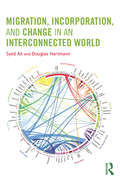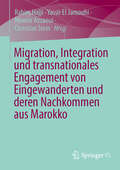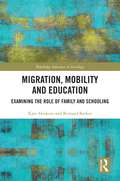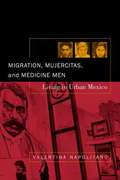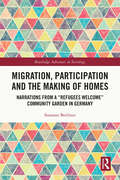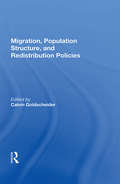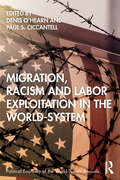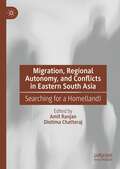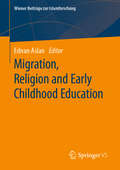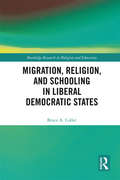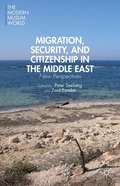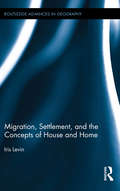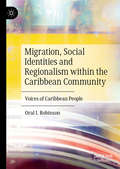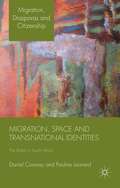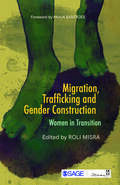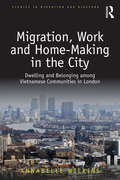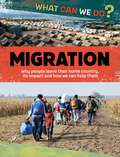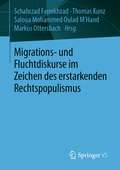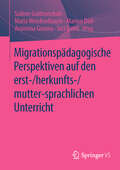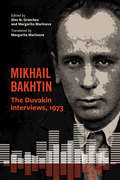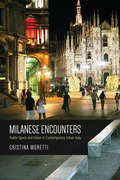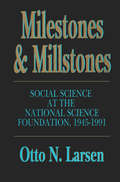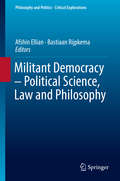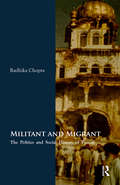- Table View
- List View
Migration, Incorporation, and Change in an Interconnected World (Sociology Re-Wired)
by Syed Ali Doug HartmannWritten in engaging and approachable prose, Migration, Incorporation, and Change in an Interconnected World covers the bulk of material a student needs to get a good sense of the empirical and theoretical trends in the field of migration studies, while being short enough that professors can easily build their courses around it without hesitating to assign additional readings. Taking a unique approach, Ali and Hartmann focus on what they consider the important topics and the potential route the field is going to take, and incorporate a conceptual lens that makes this much more than a simple relaying of facts.
Migration, Integration und transnationales Engagement von Eingewanderten und deren Nachkommen aus Marokko
by Christian Stein Rahim Hajji Yassir El Jamouhi Mounir AzzaouiAm 21. Mai 2023 jährte sich zum 60. Mal der Abschluss des Gastarbeiteranwerbeabkommens zwischen Deutschland und Marokko. Mehr als ein halbes Jahrhundert ist seitdem vergangen, und heute leben schätzungsweise 4,5 bis 5 Millionen Menschen marokkanischer Herkunft in verschiedenen Teilen der Welt. Zu den Ländern mit bedeutenden marokkanischen Gemeinschaften zählen Spanien, Italien, Frankreich, Belgien, Deutschland und die Niederlande. Vor diesem Hintergrund stellt sich die Frage, wie die Migration, Integration und das transnationale Engagement von Menschen marokkanischer Herkunft erklärt werden können. Der Sammelband mit dem Titel „Migration, Integration und transnationales Engagement von Eingewanderten und deren Nachkommen aus Marokko&“ bietet dazu verschiedene Beiträge unter anderem aus Deutschland, Frankreich, Italien, Marokko und den Niederlanden, die Antworten auf diese Fragen liefern.
Migration, Mobility and Education: Examining the Role of Family and Schooling (Routledge Advances in Sociology)
by Kate Hoskins Bernard BarkerThis book examines the role of family and schooling through an interpretive, qualitative, intergenerational case study. It examines the formation of academic and vocational aspirations by second generation (G2) migrant students from diverse international backgrounds. Looking at the influence of family background, the changes and impacts of the migrant experience, and the effectiveness of the Academy, Hoskins and Barker interpret the successes of a cohort of sixth form migrant students from diverse backgrounds. They ask key questions about how participants perceive their lived experiences and imagined futures; how their aspirations and identities relate to their background circumstances; and in what ways the school and teachers enable and facilitate their future progress and potential career pathways. The findings challenge prevailing pessimism about the role of families and schools in enabling social mobility; and suggests the possibility that there may be important messages here for social mobility more widely. How do G2 migrants buck the trend?A valuable resource for scholars of social mobility as well as for educators – especially those working with migrant learners. The use of theory, policy analysis and genealogy will provide students with accessible social mobility case studies.
Migration, Mujercitas, and Medicine Men: Living in Urban Mexico
by Valentina NapolitanoValentina Napolitano explores issues of migration, medicine, religion, and gender in this incisive analysis of everyday practices of urban living in Guadalajara, Mexico.
Migration, Participation and the Making of Homes: Narrations from a “Refugees Welcome” Community Garden in Germany (Routledge Advances in Sociology)
by Susanne BerlinerThis book is an ethnographic inquiry into the socio-ecological relationalities in an intercultural community garden in Germany, created in 2015 as a Refugees Welcome project. It explores this quietly political space of civic everyday which seeks to foster care for both people and planet. In three narrations, the book offers power-critical reflections on social encounters, participation, (in)equalities, and home-making. In innovative ways, the narrations also shed light on how people’s doings are entangled with the more-than-human – plants, soils, animals, water and more.Migration, Participation and the Making of Homes increases our understanding of how communities navigate social heterogeneity and how people with refugee biographies shape their surroundings as active agents. The narrations show that a cosmopolitan spirit is alive in this garden, and the plants play a significant part in its expression. Yet, while the garden works as a retreat from hostilities that people may experience outside, it also remains a racialised space. Power relations work in complex ways, positioning individuals as “not belonging” where conflicts occur. At the same time, in instances less shaped by the local habitus, new dynamics develop between “guest” and “host”. The narrations demonstrate how all people in the garden are engaged in unique home-making processes, and in the making of the shared home which is the garden. The gardeners connect in the joy of tending and watching life grow, as the plants speak in their own way about vital continuity.Contributing to the social scientific exploration of the dynamics of migration, belonging, and community making in pluralistic societies, this book takes a transdisciplinary shape, entering into dialogue with literature from various fields. As such, it will be of interest for researchers and university students of all levels in the areas of sociology, education, social work, anthropology, environmental studies, political science and related fields. This book will also be useful for (civil) organisations working in refugee support and/or integration, policymakers and (local) governments.
Migration, Population Structure, And Redistribution Policies
by Calvin GoldscheiderThis book analyses the links between migration and the composition, structure, and geographic distribution of populations. It discusses the evolution of population redistribution policies in Brazil, and examines internal migration between the 1930s and the 1980s.
Migration, Racism and Labor Exploitation in the World-System (Political Economy of the World-System Annuals)
by Denis O’Hearn; Paul S. CiccantellThis book offers a historically sweeping yet detailed view of world-systemic migration as a racialized process. Since the early expansion of the world-system, the movement of people has been its central process. Not only have managers of capital moved to direct profitable expansion; they have also forced, cajoled or encouraged workers to move in order to extract, grow, refi ne, manufacture and transport materials and commodities. The book offers historical cases that show that migration introduces and deepens racial dominance in all zones of the world-system. This often forces indigenous and imported slaves or bonded labor to extract, process and move raw materials. Yet it also often creates a contradiction between capital’s need to direct labor to where it enables profitability, and the desires of large sections of dominant populations to keep subordinate people of color marginalized and separate. Case studies reveal how core states are concurrently users and blockers of migrant labor. Key examples are Mexican migrants in the United States, both historically and in contemporary society. The United States even promotes of an image of a society that welcomes the immigrant—while policy realities often quite different. Nonetheless, the volume ends with a vision of a future whereby communities from below, both activists and people simply following their communal interests, can come together to create a society that overcomes racism. Its final chapter is a hopeful call by Immanuel Wallerstein for people to make small changes that, together, can bring real about real, revolutionary change.
Migration, Regional Autonomy, and Conflicts in Eastern South Asia: Searching for a Home(land)
by Amit Ranjan Diotima ChattorajDelving into the past and present of various secessionist movements in Northeast India, political conflict in Chittagong Hill Tracts in Bangladesh, a political movement for autonomy in Darjeeling hills in Eastern India, and the Rohingya migration crisis affecting India and Bangladesh, this book examines the volatile co-existence of competing population groups in Eastern South Asia. Through the conceptual lens of the ‘home’ and feeling of ‘homeland’ in Eastern South Asia, the authors seek answers to three complex but interrelated questions: why is Eastern South Asia facing so many political movements and conflicts? How have the political movements affected the region and people? Why is the number of migrants in this region so high? Answers to these questions are vital to those studying South Asia and interested in understanding this region.
Migration, Religion and Early Childhood Education (Wiener Beiträge zur Islamforschung)
by Ednan AslanAlthough it is rarely given sufficient consideration in either scholarly or political debates, early childhood education plays a crucial role in the integration process of young immigrants in European countries, since it not only enables the children to be integrated into society, both linguistically and culturally, but it also provides their parents with the opportunity, through their children, to view the society more directly and to reflect on their own values in the encounter, or to potentially seek new orientations. The quality of young migrants’ educational achievements, which have repeatedly caused current political debates in European countries, should not be considered independently of the elementary education measures since they are very closely related.Prof. Dr. Ednan Aslan is Chair of Islamic Religious Education at the Institute for Islamic Theological Studies at the University of Vienna.
Migration, Religion, and Schooling in Liberal Democratic States (Routledge Research in Religion and Education)
by Bruce A. ColletSpeaking to an increasingly fluid world involving the migration of peoples and cultures, the global resilience of religion, and the role of schooling in fostering liberal democratic values, this book investigates the degree to which secular public schools might facilitate religious migrants’ societal integration. Adopting a multidisciplinary approach which draws from political philosophy, the philosophy of education, and the sociology of religion, Collet argues that public schools in liberal democratic states can best facilitate the pluralistic integration of religious migrant students through adopting policies of recognition and accommodation that are not only reasonable in the light of liberal democratic principles, but also informed in terms of what we understand regarding the natural role religion often plays in acculturation.
Migration, Security, And Citizenship In The Middle East
by Peter Seeberg Zaid EyadatThis volume addresses new tendencies related to migration from a Middle Eastern and Mediterranean perspective and with an emphasis on security and citizenship. Contributors aim not only to intervene in scholarly debates surrounding citizenship and migration but also to contribute to policy-oriented discussions related to migration.
Migration, Settlement, and the Concepts of House and Home (Routledge Advances in Geography)
by Iris LevinHow do migrants feel "at home" in their houses? Literature on the migrant house and its role in the migrant experience of home-building is inadequate. This book offers a theoretical framework based on the notion of home-building and the concepts of home and house embedded within it. It presents innovative research on four groups of migrants who have settled in two metropolitan cities in two periods: migrants from Italy (migrated in the 1950s and 1960s) and from mainland China (migrated in the 1990s and 2000s) in Melbourne, Australia, and migrants from Morocco (migrated in the 1950s and 1960s) and from the former Soviet Union (migrated in the 1990s and 2000s) in Tel Aviv, Israel. The analysis draws on qualitative data gathered from forty-six in depth interviews with migrants in their home-environments, including extensive visual data. Levin argues that the physical form of the house is meaningful in a range of diverse ways during the process of home-building, and that each migrant group constructs a distinct form of home-building in their homes/houses, according to their specific circumstances of migration, namely the origin country, country of destination and period of migration, as well as the historical, economic and social contexts around migration.
Migration, Social Identities and Regionalism within the Caribbean Community: Voices of Caribbean People
by Oral I. RobinsonThis book offers a theoretical and substantive analysis of intra-Caribbean migration, perception of regionalism, and the construction of identities among Caribbean nationals. Through a multi-methods study in the 15 member countries of the Caribbean community, Oral Robinson explores how intra-Caribbean migrants experience living within different member countries, and how these experiences and perceptions influence ideas about citizenship, belonging, and identity. Responding directly to the lack of scholarship on how Caribbean nationals feel about integration and/or free movement within their own countries and other Caribbean countries, this volume attempts to understand Caribbean societies historically, theoretically, and methodologically; proposes bases of social identities in the Caribbean; and examines how intra-Caribbean migrants negotiate their identities and narrate their lived experiences as intra-Caribbean migrants. The book offers policy solutions based upon its findings, reconciling practice, theory, and migration policies in the Caribbean.
Migration, Space and Transnational Identities
by Daniel Conway Pauline LeonardThis timely text explores the lives, histories and identities of white British-born immigrants in South Africa, twenty years after the post-apartheid Government took office. Drawing on over sixty in depth biographical interviews and ethnographic work in Johannesburg, Pietermaritzburg and Cape Town, Daniel Conway and Pauline Leonard analyse how British immigrants' relate to, participate in and embody South Africa's complex racial and political history. Through their everyday lives, political and social attitudes, relationships with the places and spaces of South Africa, as well as their expectations of the future, the complexities of their transnational, raced and classed identities and senses of belonging are revealed. Migration, Space and Transnational Identities makes an important contribution to sociological, geographical, political and anthropological debates on transnational migration, whiteness, Britishness and lifestyle, tourism and labour migration.
Migration, Trafficking and Gender Construction: Women in Transition
by Roli MisraBringing together essays on India, Bangladesh, Myanmar and Europe, Migration, Trafficking and Gender Construction: Women in Transition offers valuable insights on women’s migration and demonstrates how tremendous political upheavals—the partition of India, the creation of Burma or the breakup of the Soviet Union and Yugoslavia—bring about new geography, demography and economies that are conducive to people’s displacement. Immigrants face racial-ethnic stratification, location segregation in ghettoes or camps and difficulties to access economic opportunities, leading usually to downward assimilation. Emphasizing intersectionality between gender and migration, the book highlights women’s experiences holistically and also shows how migration is closely aligned to trafficking. Through narratives, case studies and secondary data from different regions and countries, it points out the very different significance of female labour migration compared to men’s. Ongoing conflicts and forcible displacement against ‘newcomers’, where women are particularly vulnerable, are discussed, as are the complexities of ethnic identity. This book will give readers a comprehensive idea of the scale and complexity of women’s migration today.
Migration, Transnational Flows, and the Contested Meanings of Race in Asia (IMISCOE Research Series)
by Shanshan Lan Miloš DebnárThis open access edited volume addresses the multi-layered relations between migration, transnational flows, and the contested meanings of race in Asia. It tries to answer the following questions: how do migration and transnational flows from the Western world impact racial knowledge formation in Asian societies? To what extent do they challenge, perpetuate, and reshape unequal power relations based on the intersection of race, gender, class, nationality, citizenship, and migration status in Asia? How are dominant Western racial categories such as race, whiteness, and blackness redefined and reconstructed in the context of the Covid-19 pandemic, when transnational mobility became both heavily restricted and stigmatized ? The book is divided into three parts: Race, Language and Migration status, Covid-19 and the Dynamics of Racialization, Gender and Interracial Encounters. This book positions itself in the nexus of race, migration and pandemic research and will make a significant contribution to critical race studies, whiteness studies, globalization, multiculturalism, and social transformation in Asia. This book is aimed at students and scholars in race and migration studies in Asia and beyond. This is an open access book.
Migration, Work and Home-Making in the City: Dwelling and Belonging among Vietnamese Communities in London (Studies in Migration and Diaspora)
by Annabelle WilkinsThis book explores the relationships between home, work and migration among Vietnamese people in East London, demonstrating the diversity of home-making practices and forms of belonging in relation to the dwelling, workplace and wider city. Engaging with wider scholarship on transnationalism, urban mobilities and the geopolitical dimensions of home among migrants and diasporic communities, the author draws on ethnographic work to examine the experiences of people who migrated from Vietnam to London at different times and in diverse circumstances, including individuals who arrived as refugees in the 1970s, as well as those who have migrated for work or education in recent years. Migration, Work and Home-Making in the City thus sheds new light on the social, material and spiritual practices through which people create senses of home that connect them with their country of origin, and reveals how home-making is constrained by immigration policies, insecure housing and precarious work, thus highlighting the barriers to belonging in the city.
Migration: What Can We Do? (What Can We Do? #5)
by Cath SenkerA look at one of the biggest challenges facing our world today - migration - and how we are tackling itPeople have always moved to find work, improve their lives or to escape conflict. Most stay in their own country, but some migrate to other lands. Migrants can bring host countries a range of benefits, from filling job vacancies to making cultures more diverse, but there are also undeniable challenges, and resources can feel very stretched.How can we build a better, fairer, more equal, cleaner world? This series seeks to answer this by exploring some of the greatest challenges facing our planet today - from disease to conflict, and from the energy crisis to the plight of refugees. It explains what is already being done to meet and tackle these challenges, and explores what more could and should be done, both individually and collectively, to ensure a better future for our planet, its people and its wildlife.Taking a positive, but realistic perspective, this series aims to empower young readers by helping them understand these complex and troubling issues, calm their anxieties, and promote empathy and understanding for the many millions of people suffering from for example, poverty or inequality.Perfect for readers aged 9 and upContents:What is migration?/Why do people migrate?/Who are migrants and where do they go?/Fleeing danger: refugees and IDPs/How moving is good for migrants/Difficulties for migrants/How migration helps host countries/Problems for host countries/Helping their homelands/Brain drain and dependence/Building peace/Climate-change action/The freedom of movement debate/Glossary/Further information/IndexTitles in the series:Climate ChangeDiseaseInequalityMigrationPoverty & Food InsecurityWar & Conflict
Migrations- und Fluchtdiskurse im Zeichen des erstarkenden Rechtspopulismus
by Markus Ottersbach Thomas Kunz Schahrzad Farrokhzad Saloua Mohammed Oulad M´HandDer Band analysiert auf theoretischer Ebene rassistische und rechtspopulistische Diskurse im Kontext von Medien, Migration und Mobilität, um deren Umsetzung in politische Strategien und Praxen mittels empirischer Untersuchungen zu re- und dekonstruieren und schließlich zu diskutieren, ob und – wenn ja – wie in einer kritischen Bildungsarbeit diesen Diskursen und Praxen begegnet werden kann und muss. Dabei werden nicht nur Methoden der Bildungsarbeit, sondern auch deren Anwendungen in Arbeitsfeldern wie Schule, Hochschule und der Sozialen Arbeit thematisiert.
Migrationspädagogische Perspektiven auf den erst-/herkunfts-/mutter-sprachlichen Unterricht
by İnci Dirim Assimina Gouma Marion Döll Sabine Guldenschuh Maria WeichselbaumDer Band fokussiert empirische und theoretische Forschung zu Organisationsformen, konzeptionellen Perspektivierungen und didaktischen Ansätzen zum herkunfts- bzw. muttersprachlichen Unterricht aus migrationspädagogischer Perspektive. Welchen Beitrag leisten diese zur gesellschaftlichen Positionierung der Schüler*innen? Wie wird der Bezug zu den als „Herkunftsländer“ geltenden nationalen Kontexten hergestellt und gestaltet? Wie wird damit umgegangen, dass die Migrationssprachen nicht nur Kommunikationsmittel, sondern auch gesellschaftliche Differenzmerkmale sind?
Mikhail Bakhtin: The Duvakin Interviews, 1973
by Mikhail BakhtinWhenever Bakhtin, in his final decade, was queried about writing his memoirs, he shrugged it off. Unlike many of his Symbolist generation, Bakhtin was not fascinated by his own self-image. This reticence to tell his own story was the point of access for Viktor Duvakin, Mayakovsky scholar, fellow academic, and head of an oral history project, who in 1973 taped six interviews with Bakhtin over twelve hours. They remain our primary source of Bakhtin’s personal views: on formative moments in his education and exile, his reaction to the Revolution, his impressions of political, intellectual, and theatrical figures during the first two decades of the twentieth century, and his non-conformist opinions on Russian and Soviet poets and musicians. Bakhtin's passion for poetic language and his insights into music also come as a surprise to readers of his essays on the novel. One remarkable thread running through the conversations is Bakhtin's love of poetry, masses of which he knew by heart in several languages. Mikhail Bakhtin: The Duvakin Interviews, 1973, translated and annotated here from the complete transcript of the tapes, offers a fuller, more flexible image of Bakhtin than we could have imagined beneath his now famous texts. Published by Bucknell University Press. Distributed worldwide by Rutgers University Press.
Milanese Encounters
by Cristina MorettiIn a city driven by fashion and design, visibility and invisibility are powerful forces. Milanese Encounters examines how the acts of looking, recognizing, and being seen reflect social relations and power structures in contemporary Milan.Cristina Moretti's ethnographic study reveals how the meanings of Milan's public spaces shift as the city's various inhabitants use, appropriate, and travel through them. Moretti's extensive fieldwork covers international migrants, social justice organizations, and middle-class citizens groups in locations such as community centers, abandoned industrial areas, and central plazas and streets. Situated at the intersection of urban and visual anthropology, her work will challenge and inspire scholars in anthropology, urban studies, and other fields.Contributing to studies of urban Italy, neoliberalism, and immigration, Milanese Encounters is a welcome demonstration of ethnography's potential to analyse the connections and divisions created by complex modern cities.
Milestones and Millstones: Social Science at the National Science Foundation, 1945-1991
by Otto N. LarsenFrom the 1960s onwards, the clothing industry in the Netherlands and elsewhere in the European Union, experienced a deep crisis. Numerous went bankrupt and, even more so, workers lost their jobs. Imports from low wage countries started providing the bulk of retailers' collections.
Militant Democracy – Political Science, Law and Philosophy (Philosophy and Politics - Critical Explorations #7)
by Afshin Ellian Bastiaan RijpkemaThis volume offers an up-to-date overview of the much-debated issue of how a democracy may defend itself against those who want to subvert it. The justifications, effectiveness and legal implications of militant democracy are discussed by addressing questions as: How can militant democracy measures such as party bans be justified? Why is it that some democracies ban antidemocratic parties? Does militant democracy succeed in combatting right-wing extremism? And is militant democracy evolving into an internationalized legal and political concept?Bringing together experts and perspectives from political science, law and philosophy, this volume advances our understanding of the current threats to democracy, a political system once thought almost invincible. It is especially timely in the light of the rise of illiberal democracy in the EU, the increasingly authoritarian rule in Turkey, the steady shift to autocracy in Russia and the remarkable election of Trump in the US.
Militant and Migrant: The Politics and Social History of Punjab
by Radhika ChopraThis book is a study of the transformations in Punjab created by biotechnological revolutions, economic restructuring, persistent migrations, and political upheaval in the late 20th century. The sacred centre at Amritsar, the transnational settlement of Southall and a Doaba village form the terrain for this — three sites that can seen as metonymic spaces of identity that transcend geographic boundaries, and form the structure of this book. Relations between the rural, the sacred and the transnational, fostered through migration, marriage and material exchange, existed well before 1984. After 1984, however, and through the violent decades of the militancy period, these three locations became connected via the circulation of political ideologies, violent deaths, financial aid, a sense of disaffection, and the migration of men. Analysis of the linkages between transnational migration and religious revival is a key theme of this study. Conversely, the enhanced engagements of the diaspora with homeland politics became a source of support and created sanctuary spaces for political asylum seekers and transnational migrant labour. Re-analysing existing material and drawing on fieldwork-based interviews, as well as local history archives, the book presents a different framework to analyse the politics and social history of Punjab.
